Experimental Research on Mechanism Impairment and Reinforcement of Empty Bucket Wall
Abstract
:1. Introduction
2. Materials and Methods
2.1. Test Materials
2.2. Wall Test Design
2.2.1. Unreinforced Wall Test Design
2.2.2. Reinforced Wall Test Design
2.3. Test Equipment and Measurement Point Arrangement
2.3.1. Test Equipment without Reinforced Walls
2.3.2. Test Equipment for Reinforced Walls
2.4. Measurement Point Arrangement of the Wall
3. Empty Bucket Wall Compressive Performance Test Study
3.1. Experimental Study on the Compressive Performance of Unreinforced Walls
3.1.1. Damage Process and Morphology of Unreinforced Walls
3.1.2. Analysis of Load-Horizontal Displacement Test Results of Unreinforced Walls
3.1.3. Analysis of Load-Vertical Displacement Test Results of Unreinforced Walls
3.2. Experimental Study on the Compressive Performance of Reinforced Walls
3.2.1. Reinforced Wall Damage Process and Morphology
3.2.2. Analysis of Load-Horizontal Displacement Test Results of Reinforced Empty Bucket Wall
3.2.3. Analysis of Load-Vertical Displacement Test Results of Reinforced Empty Bucket Wall
3.3. Compression Results of Empty Bucket Walls under Different Maintenance Environments
- From the maintenance of unreinforced vacant bucket walls of the same strength in different environments in Figure 16, it can be seen that the cracking and damage loads of unreinforced vacant bucket walls in wet environments are significantly lower than their cracking and damage loads in dry environments, where for cracking loads, M 2.5–2 is 30% lower than M 2.5–1; M 5.0–2 is 28.5% lower than M 5.0–1; M 7.5–2 reduced by 25% compared to M 7.5–1, and M 10.0–2 reduced by 5.8% compared to M 10.0–1. For damage load, M 2.5–2 reduced by 10.8% compared to M 2.5–1; M 5.0–2 reduced by 9% compared to M 5.0–1; M 7.5–2 reduced by 8.4% compared to M 7.5–1, and M 10.0–2 reduced by 5.6%, indicating that the cracking load decreases more significantly for walls maintained in a humid environment, which are more affected by the wet and dry environment than those affected by the damage load. In addition, the cracking load and damage load of the empty bucket wall under the same maintenance environment both become larger with the increase in masonry mortar strength, indicating that the strength of masonry mortar has a significant effect on the overall bearing capacity of the empty bucket wall, in which the cracking load and damage load of the empty bucket wall with M 10.0 strength of this test are significantly higher than those of the other three strengths, indicating that the masonry mortar with mortar strength grade M 10 and Dalun brick combination can significantly improve the bearing capacity of the wall so that the overall bearing capacity of the wall can be significantly improved;
- Through the maintenance of reinforced vacant bucket walls of the same strength in different environments in Figure 16, it can be seen that the cracking and damage loads of the reinforced vacant bucket walls in the wet environment are significantly lower than their cracking and damage loads in the dry environment, where for cracking loads, G 2.5–2 is 6.2% lower than G 2.5–1; G 5.0–2 is 36% lower than G 5.0–1; G 7.5–2 reduced by 10.2% compared to G 7.5–1, and G 10.0–2 reduced by 14.6% compared to G 10.0–1. For damage load, G 2.5–2 reduced by 2.5% compared to G 2.5–1; G 5.0–2 reduced by 5.4% compared to G5.0–1; G 7.5–2 reduced by 5.7% compared to G 7.5–1; G 10.0–2 reduced by 4% compared to G 10.0–1 decreased by 4%, and by comparing the data, it can be seen that the cracking load of the reinforced empty bucket wall maintained in a wet environment decreased more significantly relative to that in a dry environment, and its influence by the wet and dry environment was greater than the influence by the damage load.
4. Stress–Strain Analysis of Empty Bucket Wall
4.1. Comparison of Model Curves and Test Curves of Unreinforced Walls
4.2. Stress–Strain Analysis of Reinforced Empty Bucket Wall
5. Discussion
6. Conclusions
Author Contributions
Funding
Institutional Review Board Statement
Informed Consent Statement
Data Availability Statement
Conflicts of Interest
References
- Zhu, R. The research of Seismic Strengthening Design Method of the Traditional Dwelling in the Rowlock Wall according to the Original Architectural Style and Features; Xi’an University of Architecture and Technology: Xi’an, China, 2017. [Google Scholar]
- Li, X.; Tang, W.; Zhang, Q.; Sun, L.; Jin, G.; Ye, Q. Test study lateral resistance behavior of row lock wall. J. Nat. Disasters 2010, 19, 8–12. [Google Scholar]
- Lei, M. Study on Seismic Behavior of Row Lock Wall and Row Lock Wall Strengthened with HPFL; Hunan University: Changsha, China, 2013. [Google Scholar]
- Wang, Z.; LI, X.; Gao, R.; Zhang, Y.; Xu, Q. Experimental research on seismic performance of brick walls strengthened by fiber-reinforced cement-based composite material surface layer. Build. Struct. 2021, 51, 17–25+16. [Google Scholar]
- Niu, L.; Zheng, S.; Li, L. Experimental study on the seismic behavior of masonry walls under offshore environment. Structures 2020, 28, 433–445. [Google Scholar] [CrossRef]
- Zhou, Y. Mechanical properties and seismic behavior of confined masonry walls in freeze-thaw environment. Structures 2021, 31, 647–659. [Google Scholar] [CrossRef]
- Luo, C.; Huang, Y. Experimental study on brick masonry columns strengthened with GFRP sheet under axial compression. Civ. Eng. Fujian Univ. Technol. 2013, 11, 19–23. [Google Scholar]
- Werasak, R.; Meng, J.; Ratchaneewan, K. Behaviors of Historic Masonry Walls Retrofitted with GFRP under Axial Load. Adv. Mater. Res. 2010, 133, 959–964. [Google Scholar]
- Tarek, A.; Yousef, A.-S. Behavior of FRP strengthened infill walls under in-plane seismic loading. J. Compos. Constr. 2007, 11, 308–318. [Google Scholar]
- Guerreiro, J.; Proença, J.; Ferreira, J.G.; Gago, A. Experimental characterization of in-plane behavior of old masonry walls strengthened through the addition of CFRP-reinforced render. Compos. Part B 2018, 148, 14–26. [Google Scholar] [CrossRef]
- Zhang, Z. Experimental Study on the Compressive Performance of Reclaimed Concrete Hollow Block Wall; Changsha University of Science and Technology: Changsha, China, 2018. [Google Scholar]
- Wu, H.; Chun, Y.; Xie, X.; Zhang, T.; Li, Q.; Li, C. Experimental study of EPS concrete block wall compressive strength. N. Build. Mater. 2018, 45, 103–108. [Google Scholar]
- Bu, L.; Ma, Y. Section stiffness calculation of the RC beams strengthened with PVA-ECC steel mesh. J. Railw. Sci. Eng. 2017, 14, 514–519. [Google Scholar]
- Li, P. Experimental study on the performance of CFRP-strengthened masonry structures under debris flow impacts. Structures 2021, 31, 602–612. [Google Scholar] [CrossRef]
- Li, T. Performance of axially loaded masonry columns confined using textile reinforced concrete (TRC) added with short fibers. Constr. Build. Mater. 2021, 279, 122413. [Google Scholar] [CrossRef]
- Cheng, S.; Yin, S.; Lei, J. Comparative experimental analysis on the in-plane shear performance of brick masonry walls strengthened with different fiber-reinforced materials. Constr. Build. Mater. 2020, 259, 12087. [Google Scholar] [CrossRef]
- Dong, Z. Strengthening of unreinforced masonry walls against out-of-plane loads using carbon textile reinforced mortar optimized by short PVA fibers. Eng. Struct. 2021, 227, 111433. [Google Scholar] [CrossRef]
- Zhang, H. Load Capacity and Displacement of Recycled Concrete and Self-Insulation Block Masonry Wall. Materials 2020, 13, 863. [Google Scholar] [CrossRef]
- Zhen, W.; Yan, F.; Zhang, P.; Wang, Y. Experimental study on the load capacity of brick wall strengthened with concrete splint under axial compression. J. Harbin Inst. Technol. 2018, 50, 145–151. [Google Scholar]
- Wang, H.; Wang, F.; Qian, D. Investigation of damage mechanisms related to microstructural features of ferrite-cementite steels via experiments and multiscale simulations. Int. J. Plast. 2023, 170, 103745. [Google Scholar] [CrossRef]
- Wang, Y.; Lou, M.; Wang, Y. Stochastic failure analysis of reinforced thermoplastic pipes under axial loading and internal pressure. China Ocean. Eng. 2022, 36, 614–628. [Google Scholar] [CrossRef]
- Mansour, W.; Wang, P. Experimental and numerical evaluations of the shear performance of recycled aggregate RC beams strengthened using CFRP sheets. Eng. Struct. 2024, 301, 117368. [Google Scholar] [CrossRef]
- GB/T 5101-2017; Fired Common Bricks. China National Standardization Administration: Beijing, China, 2017.
- JGJ/T 70-2009; Standard for Test Method of Performance on Building Mortar. China National Standardization Administration: Beijing, China, 2009.
- GB/T 14684-2011; Sand for Construction. China National Standardization Administration: Beijing, China, 2011.
- GB/T 50081–2002; Standard for Test Method of Mechanical Properties on Ordinary Concrete. China National Standardization Administration: Beijing, China, 2002.
- GB 50924-2014; Code for Construction of Masonry Structures Engineering. China National Standardization Administration: Beijing, China, 2014.
- GB/T 50129-2011; Standard Test Method for Basic Mechanical Properties of Masonry. China National Standardization Administration: Beijing, China, 2011.
- GB 50003-2011; Code for the Design of Masonry Structures. China National Standardization Administration: Beijing, China, 2011.
- Hao, Q. Study Onconstitutive Modelofs Teel-Pvahybrid Fiber Cementltious Composites; Wenzhou University: Wenzhou, China, 2017. [Google Scholar]


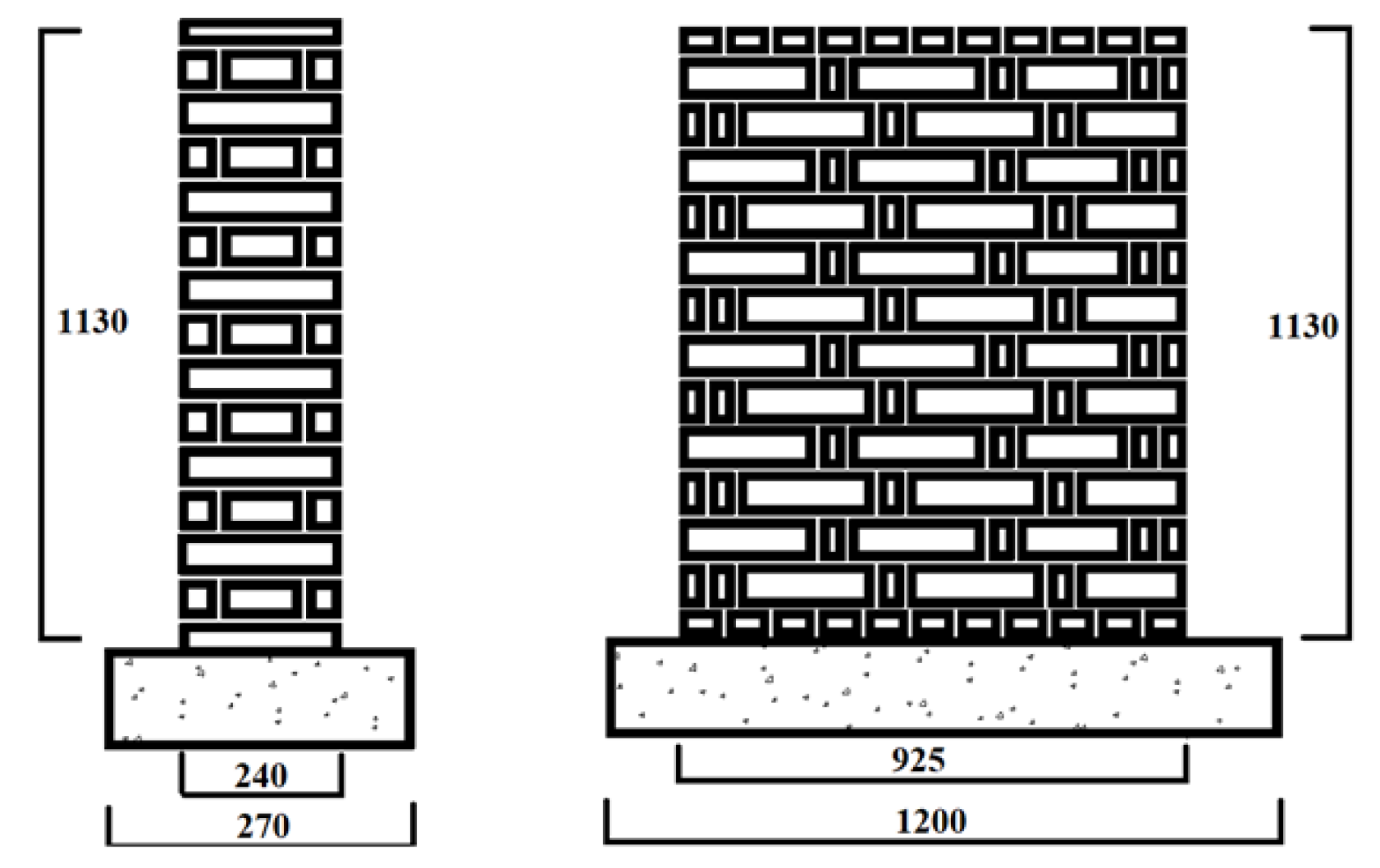
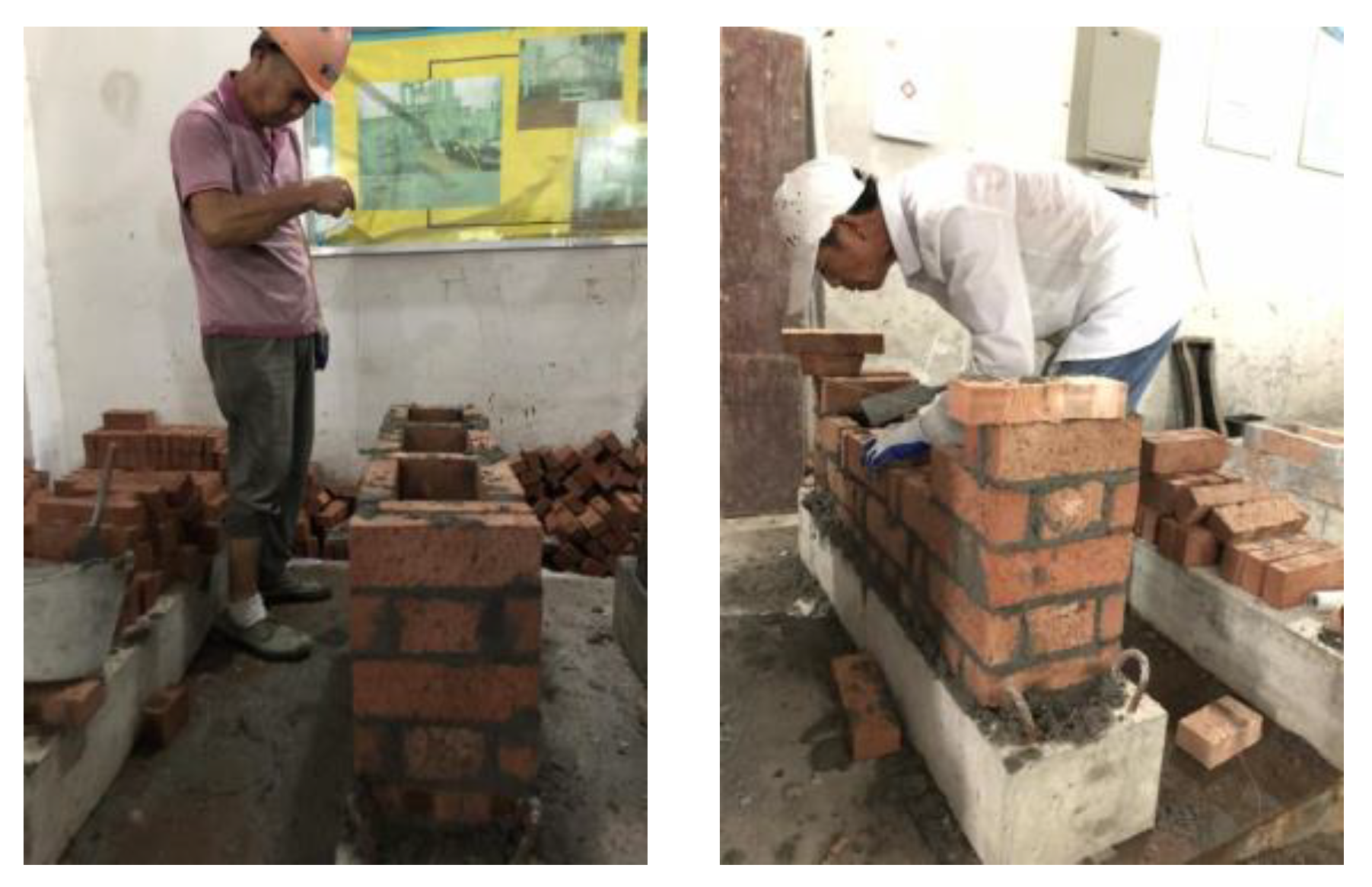



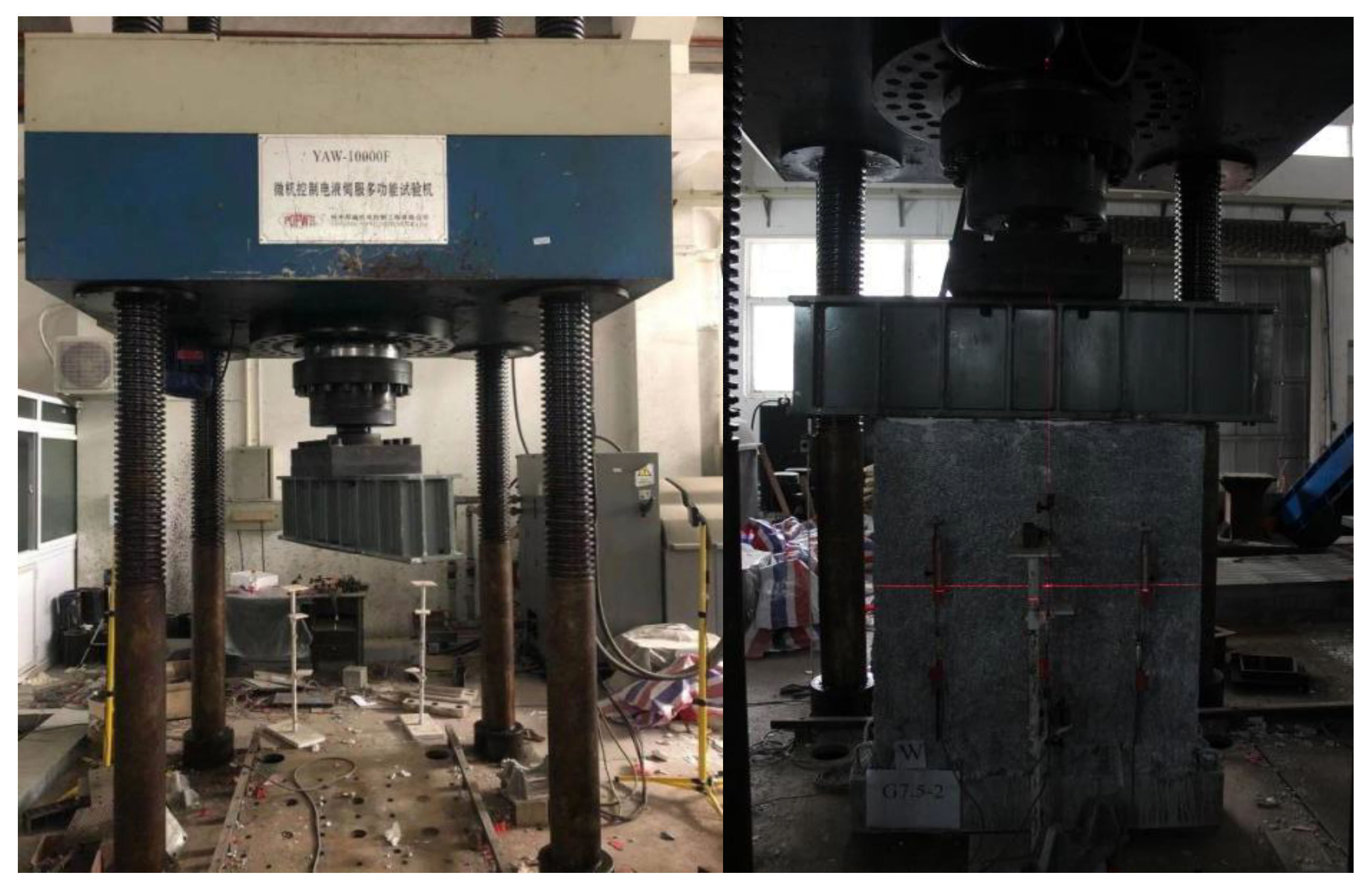

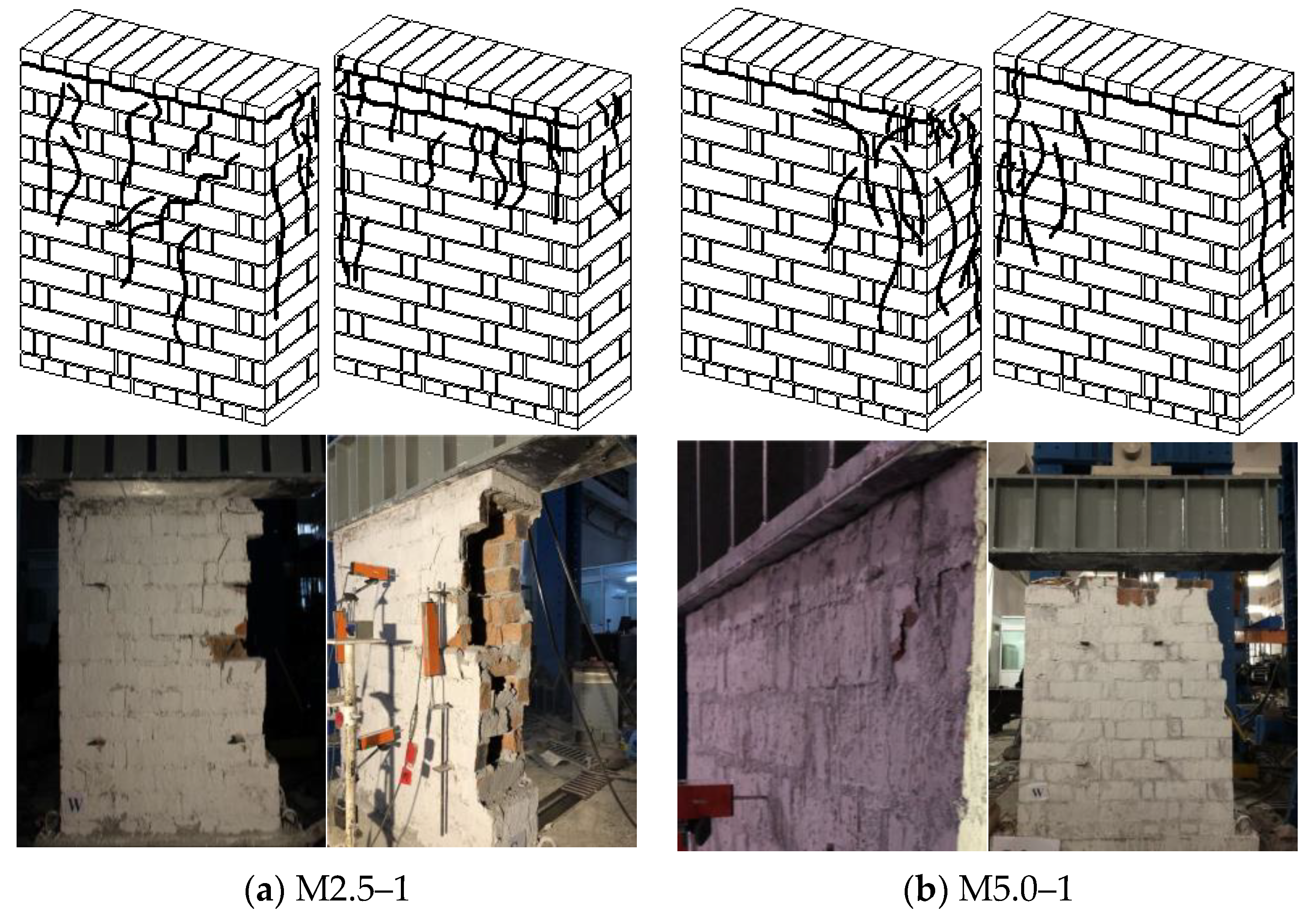

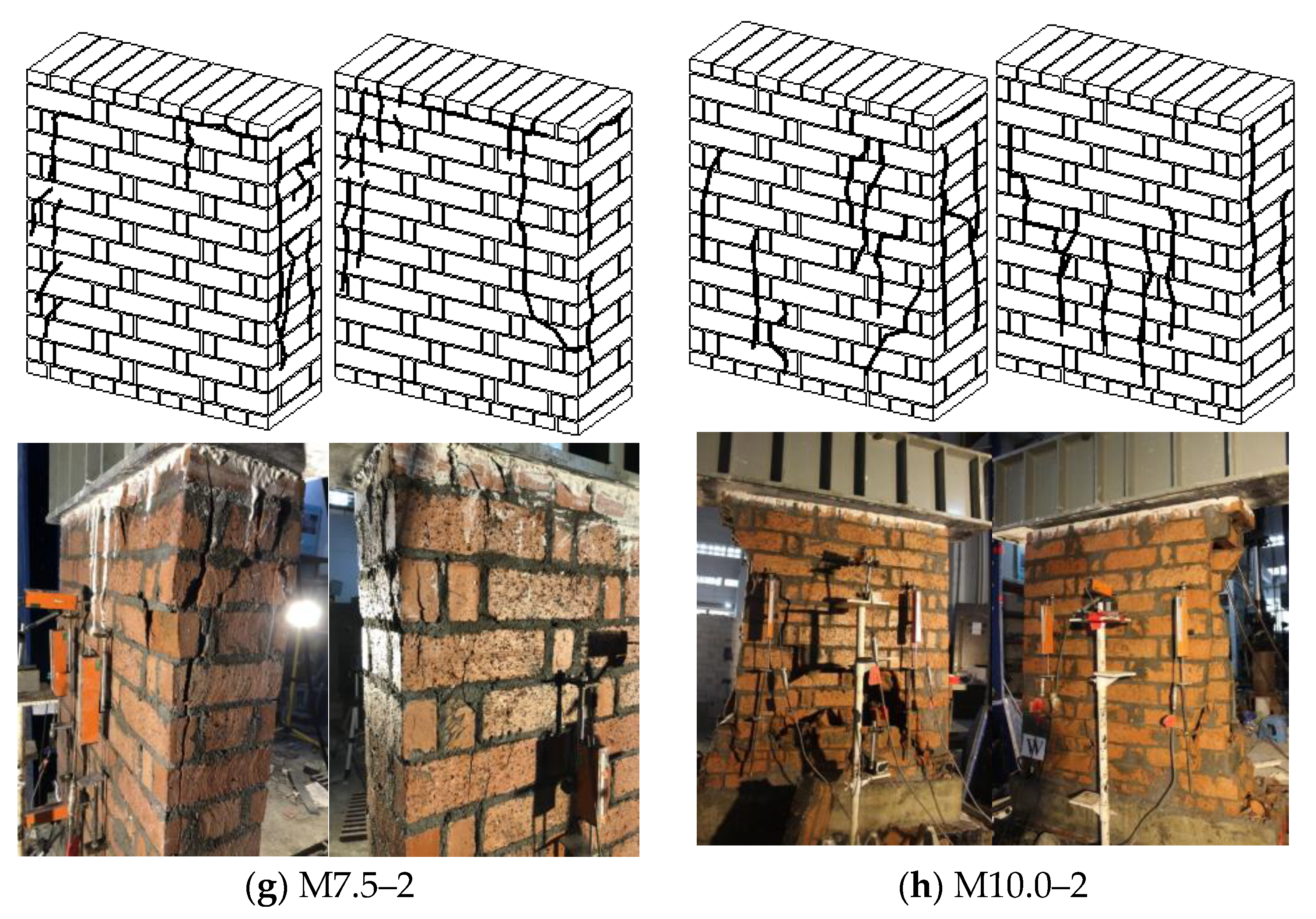

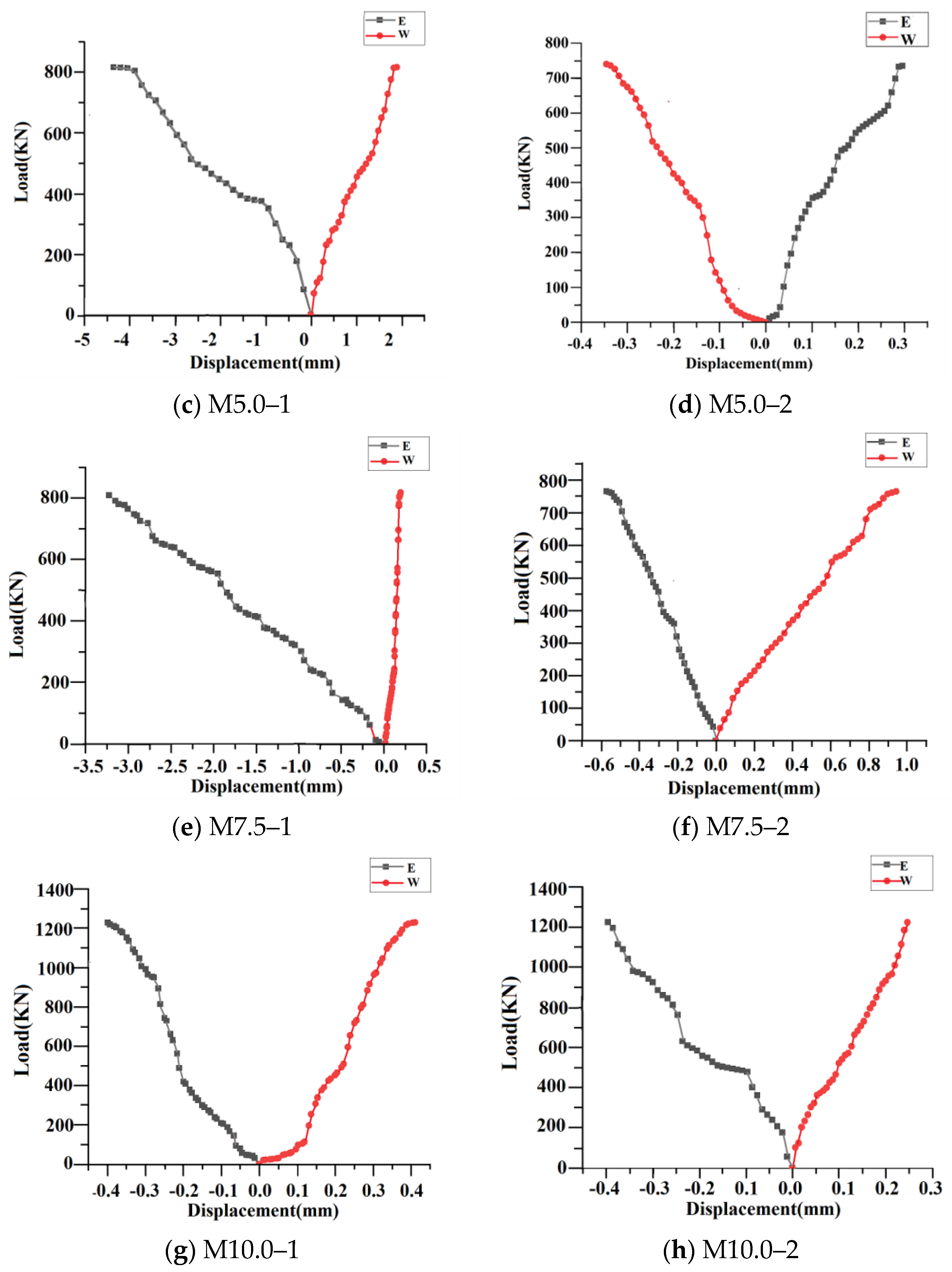
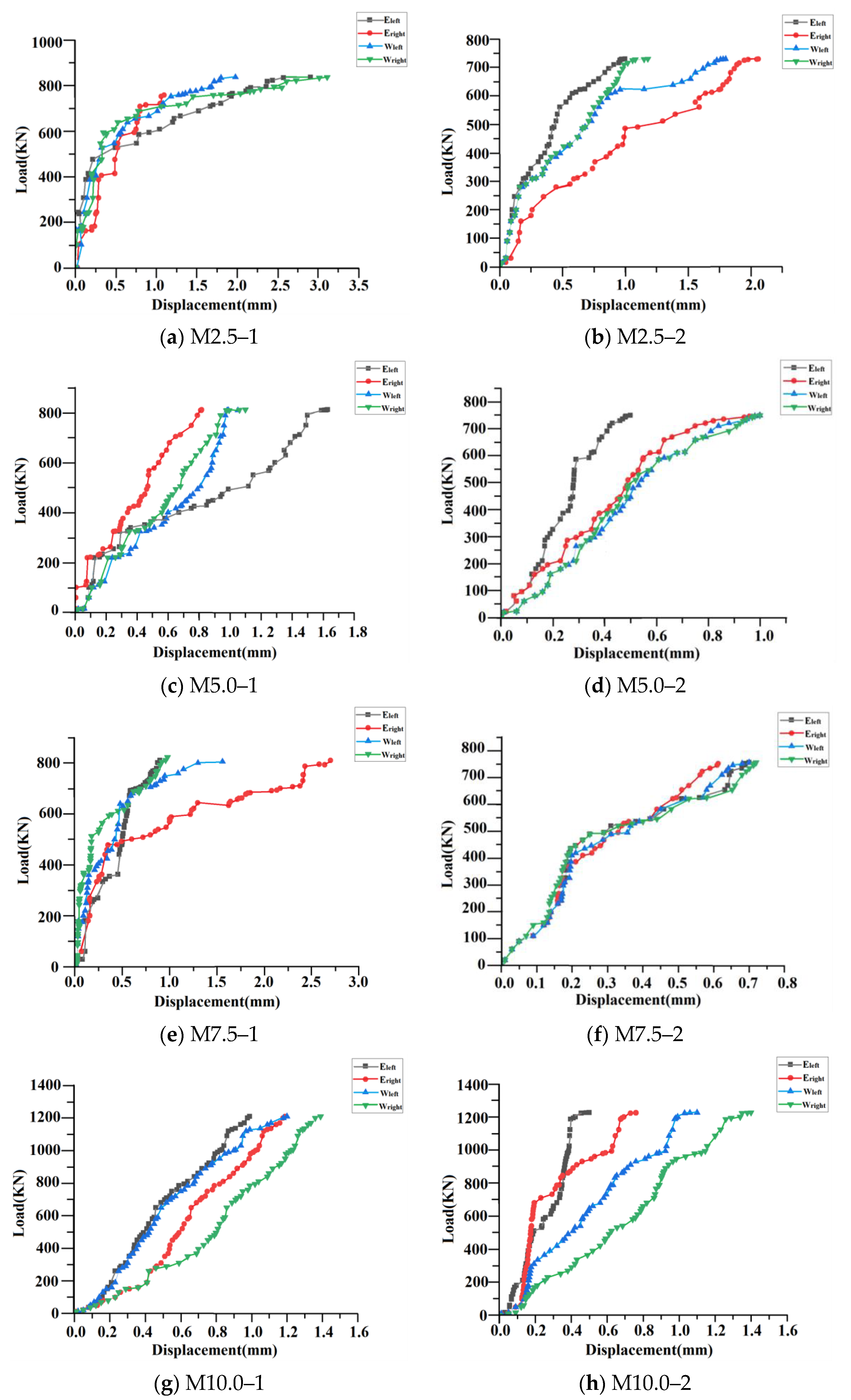


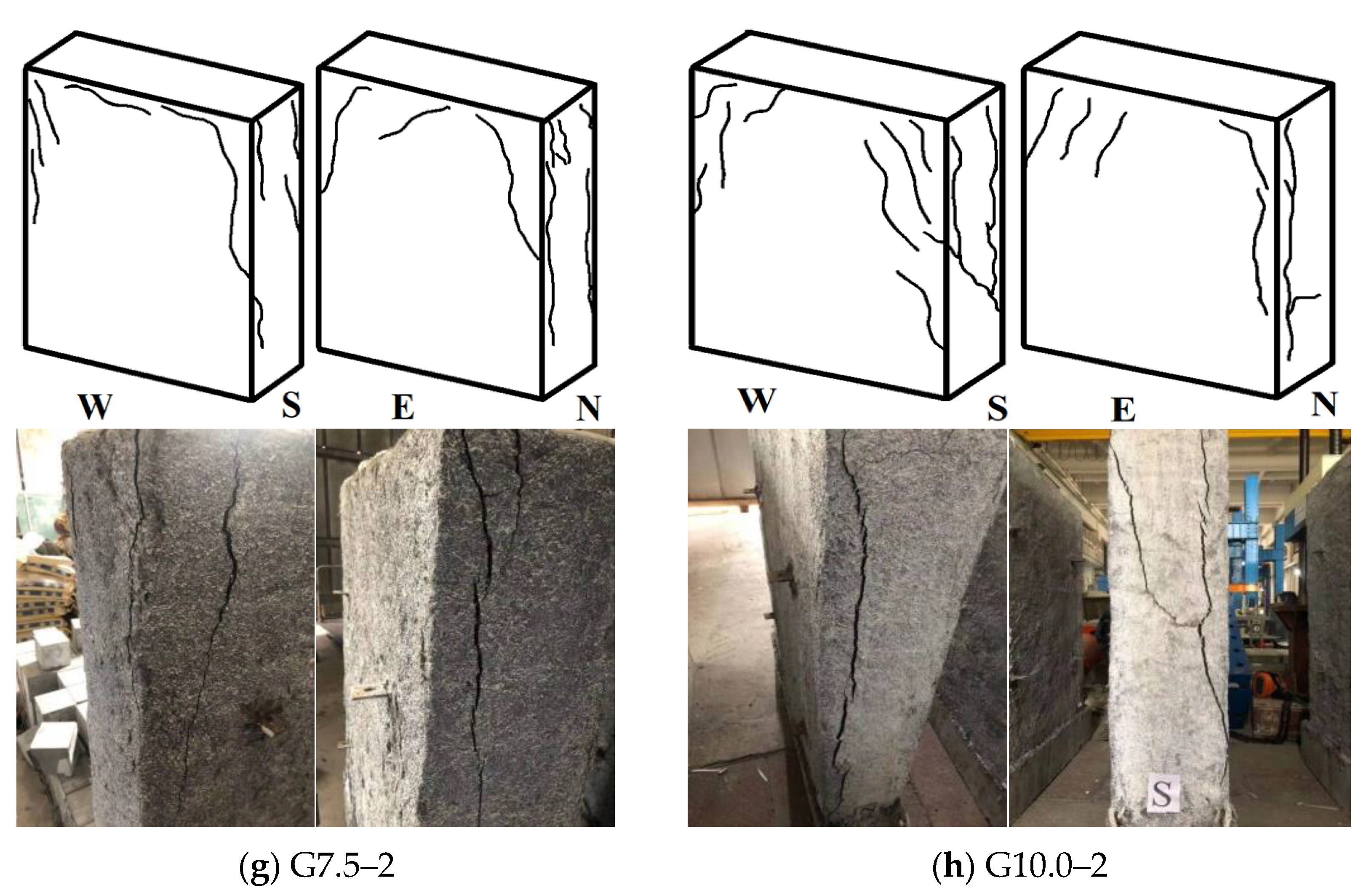
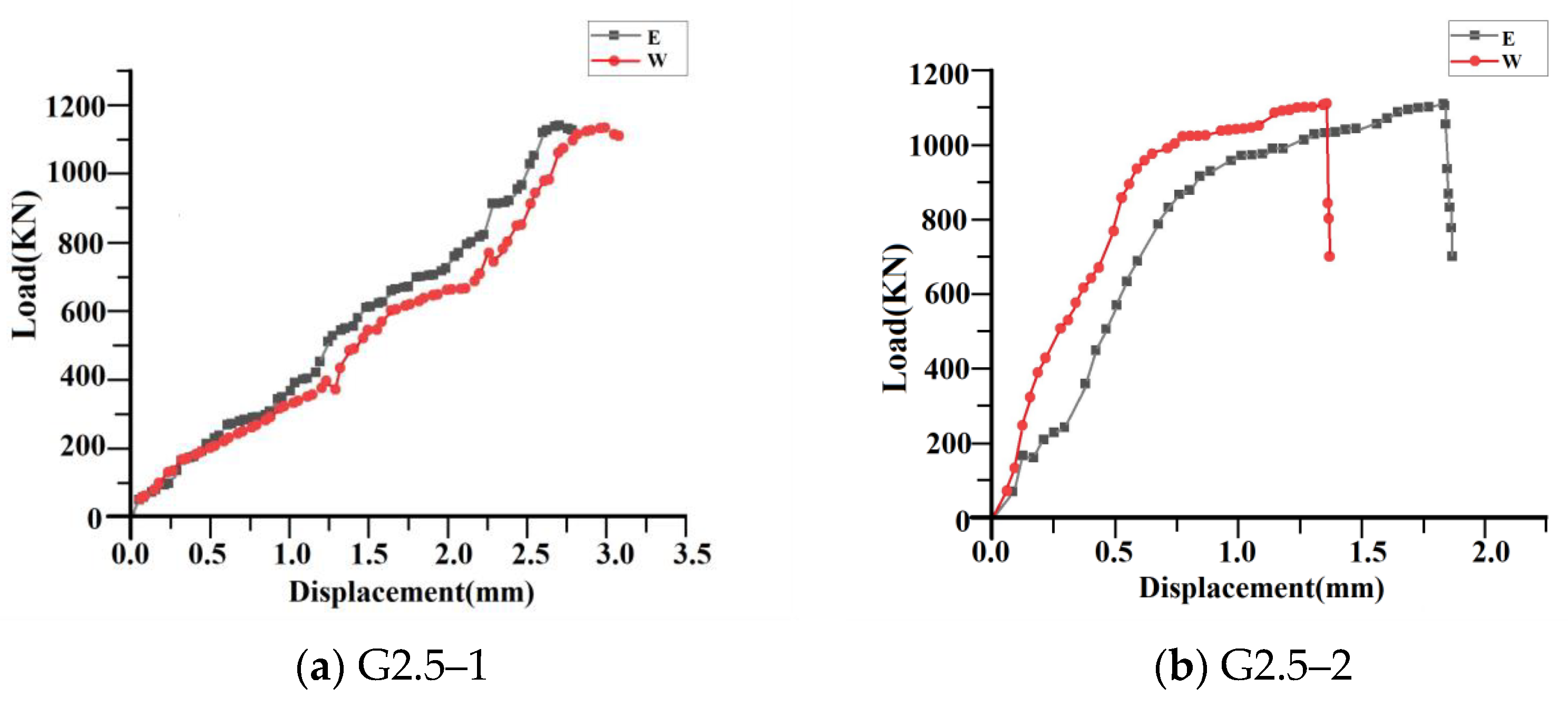
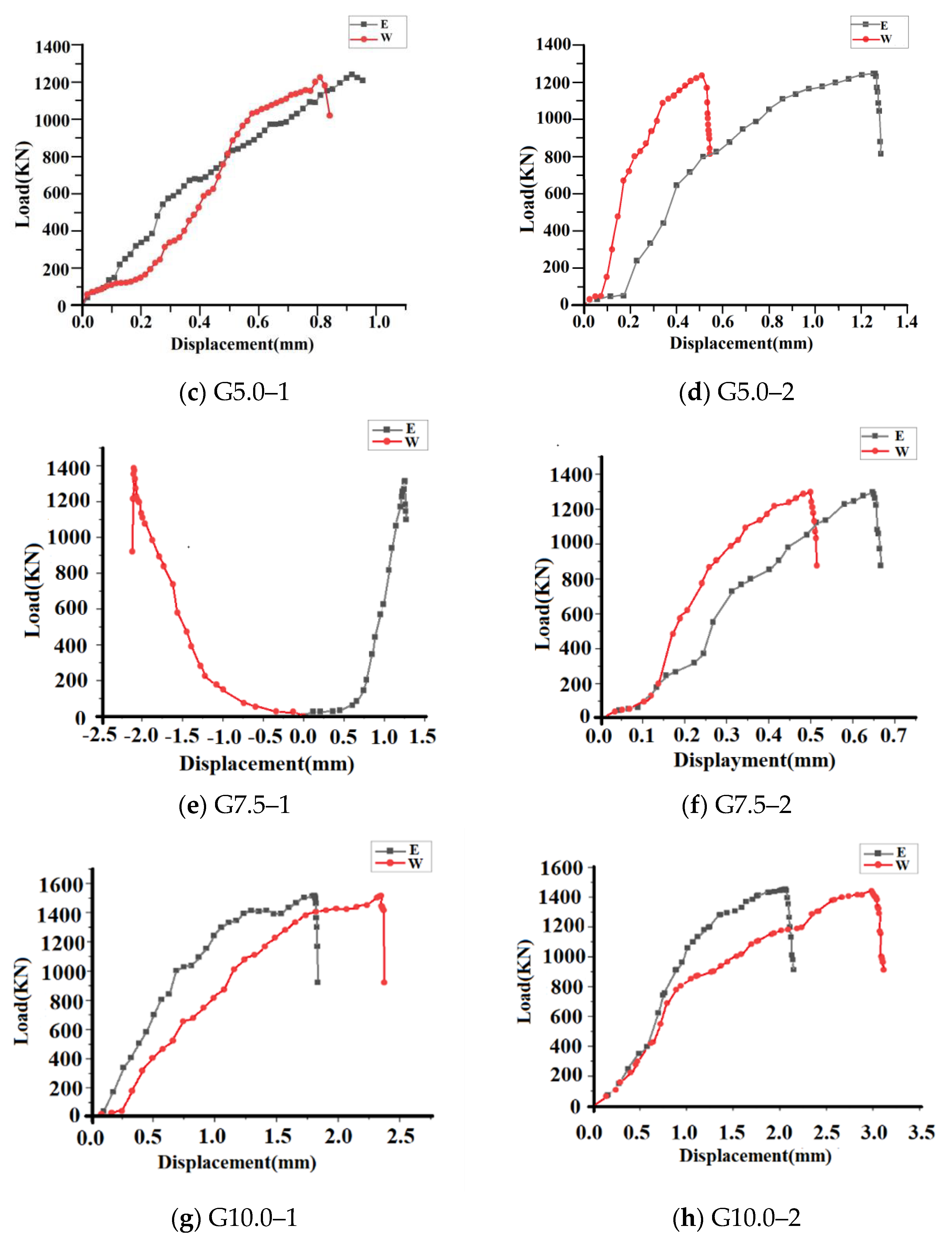
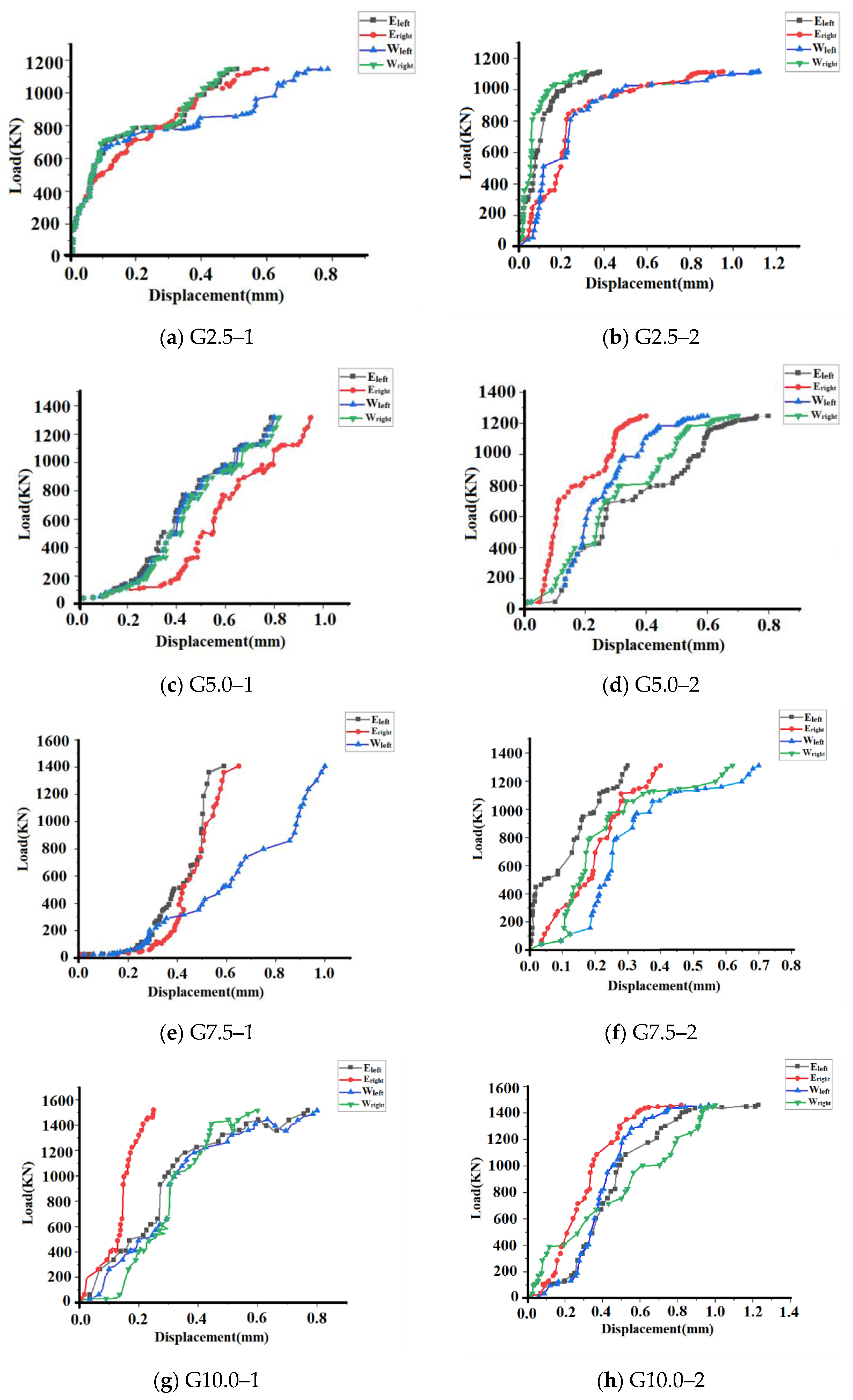
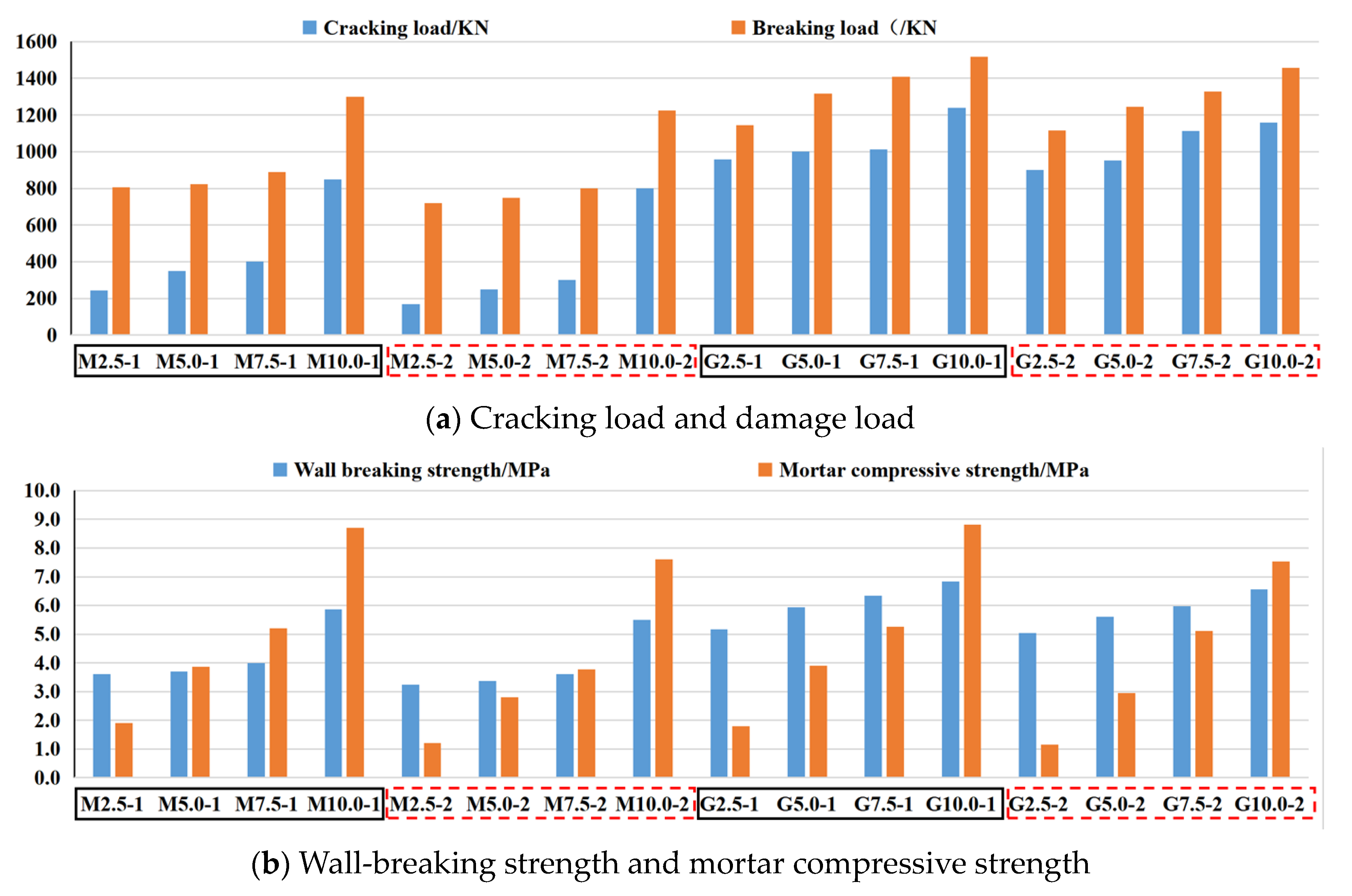
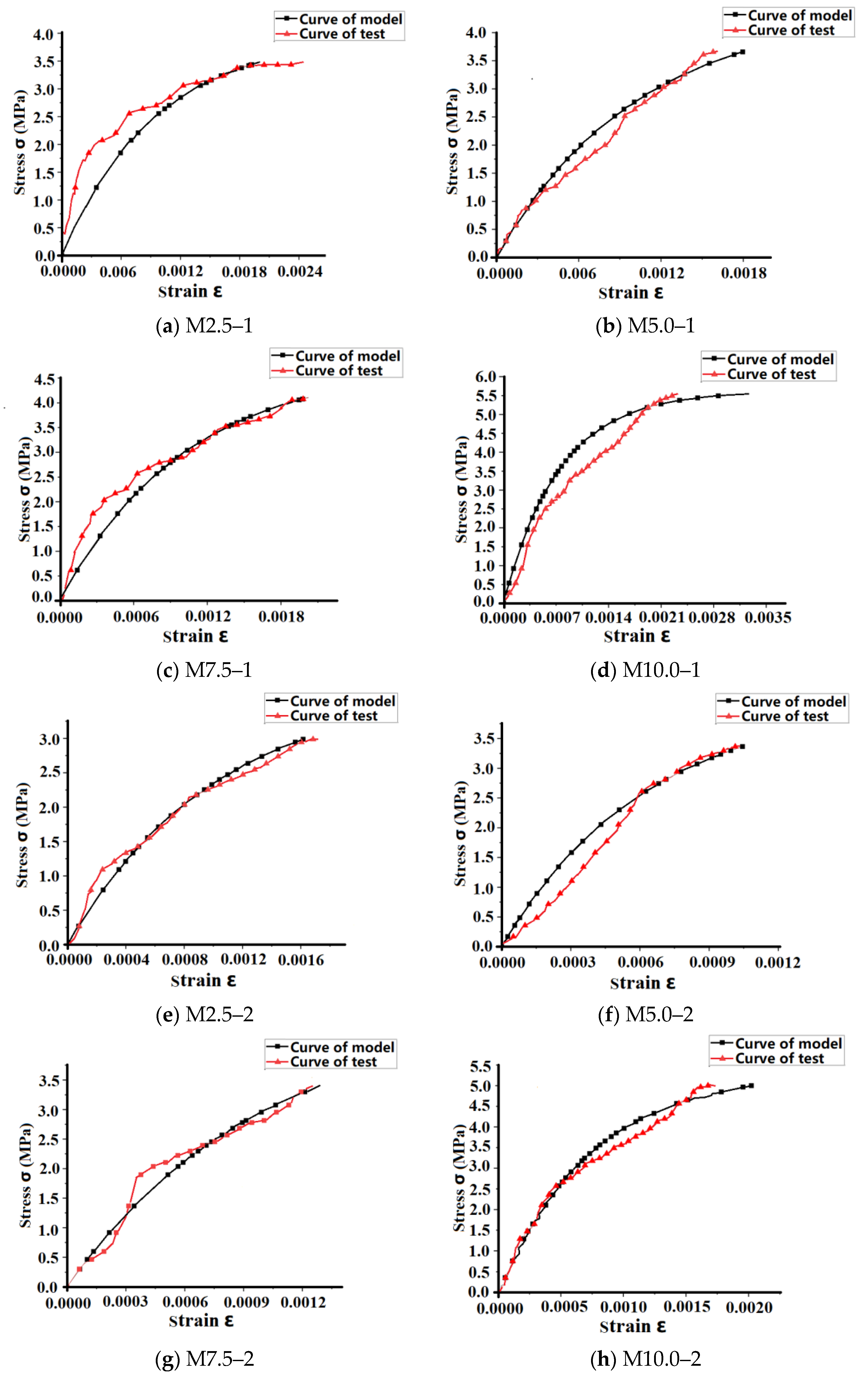
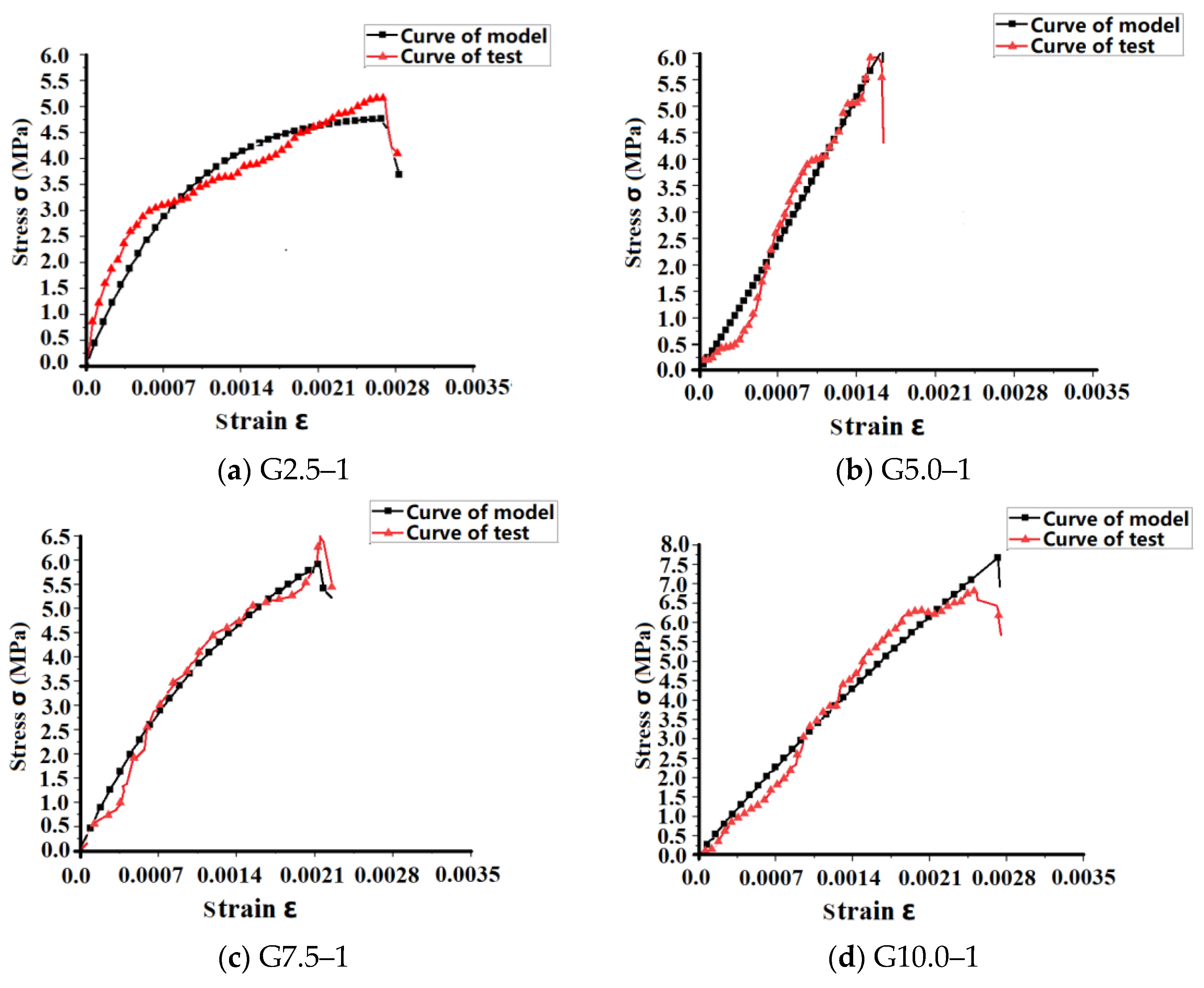
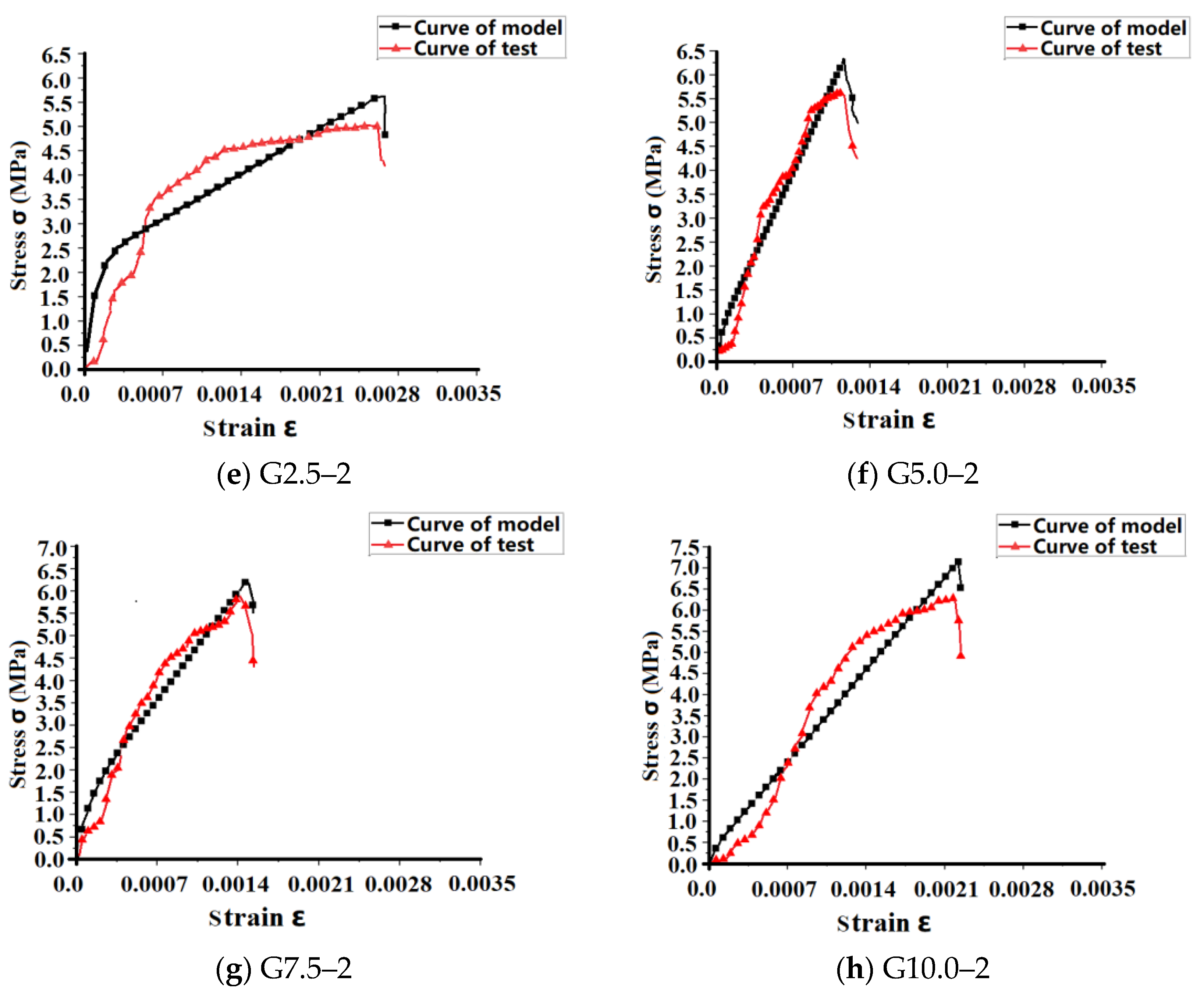
| Strength Rating | Cement (Kg/m3) | Lime (Kg/m3) | Sand (Kg/m3) | Water (Kg/m3) | Viscosity (mm) |
|---|---|---|---|---|---|
| M2.5 | 140 | 308 | 1904 | 380–400 | 70–90 |
| M5.2 | 162 | 162 | 1393.2 | 290–310 | 70–90 |
| M7.5 | 185 | 111 | 1239.5 | 250–270 | 70–90 |
| M10.0 | 290 | 87 | 1595 | 330–350 | 70–90 |
| Specimen Number | 7 Days | 14 Days | 28 Days | Viscosity (mm) |
|---|---|---|---|---|
| M2.5 | 1.25 | 1.33 | 1.50 | 70–90 |
| M5.2 | 2.81 | 3.21 | 3.80 | 70–90 |
| M7.5 | 5.35 | 6.40 | 6.50 | 70–90 |
| M10.0 | 6.91 | 8.51 | 9.43 | 70–90 |
| Specimen Number | Expressions | Parameters ξ | R2 |
|---|---|---|---|
| M2.5–1 | 532.77317 | 0.90937 | |
| M5.0–1 | 462.33762 | 0.94791 | |
| M7.5–1 | 449.8297 | 0.96613 | |
| M10.0–1 | 567.51733 | 0.90812 | |
| M2.5–2 | 496.68808 | 0.98813 | |
| M5.0–2 | 770.36236 | 0.95114 | |
| M7.5–2 | 470.23528 | 0.96958 | |
| M10.0–2 | 588.94162 | 0.90829 |
| Specimen Number | Expressions | Coefficient k1 | Coefficient k2 | R2 |
|---|---|---|---|---|
| G2.5–1 | 1.48943 | −0.01832 | 0.99103 | |
| G5.0–1 | −0.16704 | 0.27472 | 0.9884 | |
| G7.5–1 | 0.92364 | 0.06444 | 0.99585 | |
| G10.0–1 | 0.16068 | 0.16847 | 0.99105 | |
| G2.5–2 | 0.58048 | 0.08771 | 0.97671 | |
| G5.0–2 | 0.12257 | 0.33514 | 0.98378 | |
| G7.5–2 | 0.26491 | 0.22585 | 0.98443 | |
| G10.0–2 | 0.052 | 0.20587 | 0.97709 |
Disclaimer/Publisher’s Note: The statements, opinions and data contained in all publications are solely those of the individual author(s) and contributor(s) and not of MDPI and/or the editor(s). MDPI and/or the editor(s) disclaim responsibility for any injury to people or property resulting from any ideas, methods, instructions or products referred to in the content. |
© 2024 by the authors. Licensee MDPI, Basel, Switzerland. This article is an open access article distributed under the terms and conditions of the Creative Commons Attribution (CC BY) license (https://creativecommons.org/licenses/by/4.0/).
Share and Cite
Diao, R.; Cao, Y.; Li, J.; Sun, L.; Yang, F. Experimental Research on Mechanism Impairment and Reinforcement of Empty Bucket Wall. Buildings 2024, 14, 383. https://doi.org/10.3390/buildings14020383
Diao R, Cao Y, Li J, Sun L, Yang F. Experimental Research on Mechanism Impairment and Reinforcement of Empty Bucket Wall. Buildings. 2024; 14(2):383. https://doi.org/10.3390/buildings14020383
Chicago/Turabian StyleDiao, Rongdan, Yinqiu Cao, Jiangen Li, Linzhu Sun, and Fang Yang. 2024. "Experimental Research on Mechanism Impairment and Reinforcement of Empty Bucket Wall" Buildings 14, no. 2: 383. https://doi.org/10.3390/buildings14020383





